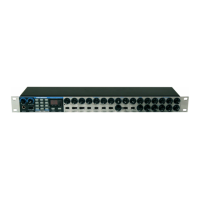from 180 degrees again. This is equivalent to two waves with a con-
stant detune.
In this example only Oscillator 1 is used again. It is set to a sawtooth
wave. The PWM position is set centrally and the PWM position from
LFO 2 is set to +63. The LFO speed is set to 50 with the LFO 2 wave-
form as a saw wave.
Try varying the LFO speed to adjust the amount of detune between the
double oscillators. Note that settings for the LFO 2 pulse amount that
are not maximum or minimum values will produce clicks in the sound
because the phase difference will be interrupted.
Sound 302 - Oscillator Sync Example
Oscillator 1 can sync Oscillator 2 so that each time Oscillator 1 com-
pletes it's cycle it resets the start cycle of Oscillator 2. When listening to
only Oscillator 2 this has a very distinctive sound.
Here the Oscillator 2 level is 100% and Oscillator levels for Oscillators
1&3 are both 0%. Oscillator 1 has no envelope modulation whereas
Oscillator 2 has a mod env depth of 45. The modulation envelope is set
with an attack of 080 and a decay of
100. The sustain and release times for the mod envelope are 000. As
the pitch of Oscillator 1 rises and falls this changes the way the
Oscillator 2 wave is reset.
Try experimenting with the modulation envelope settings, the mod env
depth amount for Oscillator 2 and the Octave / Semitone settings for
Oscillators 1&2.
Sound 303 - Ring Mod Example
Here all the Oscillator levels are set to 000. The Ring Mod level is set
to 100%. The modulation envelope has an attack setting of 035 and a
decay setting of 105. The mod env amount is set to +50 for Oscillator 2
and -40 for Oscillator 1.
Try experimenting with the modulation envelope settings, the mod env
depth amount for Oscillators 1&2 and the octave / semitone settings for
Oscillators 1&2.
Sound 304 - Main Output EQ Filter Example.
The additional main output tempo sync'ed enveloped filter.
This is a powerful eq filter which is at the output stage of the signal path
of the A-Station. This can boost frequencies as well as attenuate them -
compared the low pass filter which can only attenuate. Positive settings
of the amount control will boost frequencies above the frequency point
and attenuate frequencies below it. Negative settings of the eq amount
will attenuate frequencies above the frequency point and boost frequen-
cies below it.
The key point to this feature is the EQ Depth control. This will use a
dedicated LFO to move the frequency point of the eq. The eq LFO can
be sync'ed to midi clock or to the arpeggiator clock and an eq initial
position can also be set just like for the chorus and pan effects.
This example has been set up for use with an external input. It will work
particularly well with drum loops etc. Try varying the amp envelope con-
trols and the eq level, depth, rate and frequency controls.
A-2
Factory Preset Sounds Listing and Examples
Appendix

